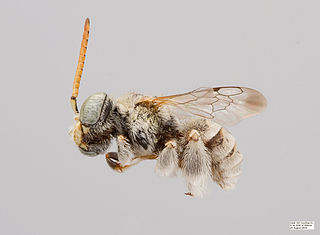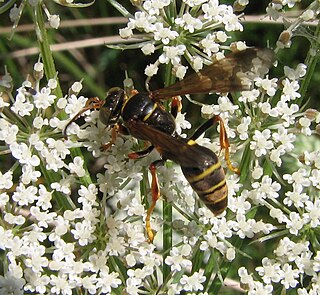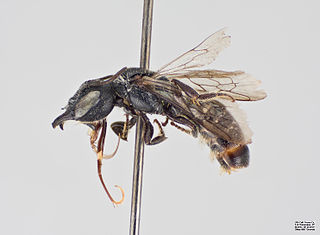
Perdita is a large genus of small bees native to North America, particularly diverse in the desert regions of the United States and Mexico. There are over 600 currently recognized species of Perdita, plus more than 100 additional subspecies and many more species that remain undescribed. Perdita are usually quite small and often brightly colored with metallic reflections and/or yellow or white markings, and among the few lineages of bees incapable of stinging. The genus was extensively treated by P.H. Timberlake who, in addition to T.D.A. Cockerell, described most of the known species. Most species are extreme specialists (oligoleges) with respect to pollen and will only collect pollen from a few closely related species or genera of plants. Many species in this genus are called fairy bees.

Dianthidium is a genus of leafcutter, mason, and resin bees in the family Megachilidae. There are at least 20 described species in Dianthidium.

Hoplisoides is a genus of sand wasps in the family Bembicidae. There are at least 70 described species in Hoplisoides.

Ashmeadiella is a genus of bees in the family Megachilidae. There are more than 60 described species in Ashmeadiella.
Sphecodosoma is a genus of sweat bees in the family Halictidae. There are at least three described species in Sphecodosoma.

Rophitinae is a subfamily of sweat bees in the family Halictidae. There are about 13 genera and more than 260 described species in Rophitinae.
Clitemnestra is a genus of sand wasps in the family Bembicidae. There are at least 60 described species in Clitemnestra.
Palmodes is a genus of thread-waisted wasps in the family Sphecidae. There are more than 20 described species in Palmodes.

Anthophorula is a genus of bees in the family Apidae. There are more than 60 described species in Anthophorula.

Microbembex is a genus of sand wasps in the family Bembicidae. There are more than 30 described species in Microbembex.
Glenostictia is a genus of sand wasps in the family Bembicidae. There are more than 20 described species in Glenostictia.

Ancylandrena is a genus of mining bees in the family Andrenidae. There are about five described species in Ancylandrena.

Ammoplanops is a genus of aphid wasps in the family Ammoplanidae. There are about 15 species described in the genus Ammoplanops.

Protandrena is a genus of mining bees in the family Andrenidae. Depending upon whose definition of the genus one follows, there are anywhere from 50 to 180 described species in Protandrena; traditional classifications recognize 7 subgenera, some of which are sometimes elevated to genus rank, and other classifications place many of these species in the related genus Pseudopanurgus (e.g.), leaving Protandrena with a much smaller constituency. In the most inclusive definition, they are found from Canada through Argentina. However, there is current disagreement whether the Protandrena in South America belong to different genera, in which case the genus extends only as far south as Panama. They are solitary bees, but some species nest in aggregations. They prefer to nest in sunny areas with sparse vegetation. The underground nests have cells lined with a chemical substance. This "wallpaper" acts as a barrier between fungi and bacteria. The eggs hatch, the larvae develop, and then overwinter as mature larvae with hardened skin. They are primarily active from May to October, but have been noted to be active in April in the region six of the United States.
Larropsis is a genus of square-headed wasps in the family Crabronidae. There are more than 40 described species in Larropsis.
Micralictoides is a genus of sweat bees in the family Halictidae. There are about eight described species in Micralictoides.

Saygorytes is a genus of sand wasps in the family Bembicidae. There are about seven described species in Saygorytes.

Protosmia is a genus of subgenus Chelostomopsis in the family Megachilidae. There are more than 30 described species in Protosmia.

Psammaletes is a genus of sand wasps in the family Bembicidae. There are about nine described species in Psammaletes.












